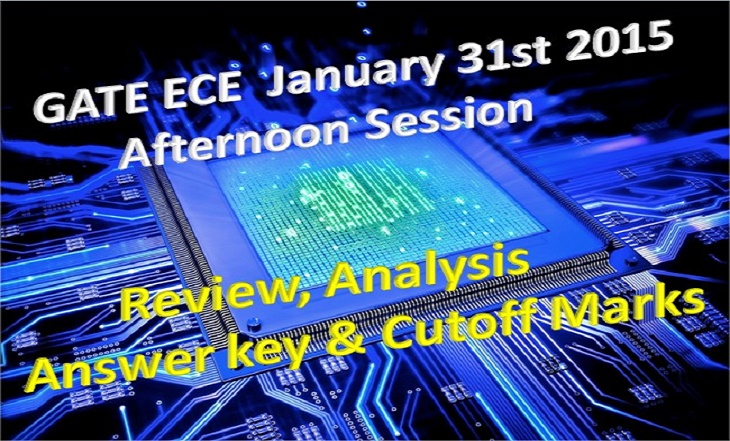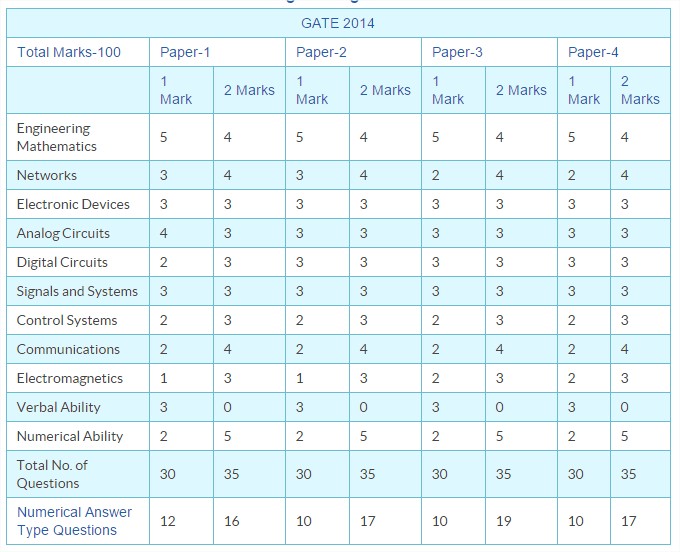GATE ECE Answer Key 2015 Download 31 Jan Afternoon Session EC Solutions Analysis Cut Off by Made Easy IIT ACE / IES Academy:
GATE ECE Answer Key 2015 Download 31 Jan Afternoon Session EC Solutions Analysis: Electronics and Communication Engineering (ECE) in gate examination the code is EC. GATE examination is very important and dream for many students to pursue their M.Tech IIT’s and NIT’s. Some students wil be preparing for the one year completely for this. Students or aspirants completed their exam on January 31 2015 Afternoon Session here we providing the information about the exam Review, Analysis, Answer key and Cutoff Marks. Those candidates in search for Review, Analysis, Answer key and Cutoff Marks will find this useful.
Also See: GATE Mechanical Engineering 31st Jan 2015 Answer Key

GATE ECE January 31 2015 Afternoon Session Review :
Comming to the review the questions are mainly based on the basics if you have concentrated on basics you would do good. You could attempt for 60% in the paper, other questions are relatively tough.
Networks: Network graphs: matrices associated with graphs; incidence, fundamental cut set and fundamental circuit matrices. Solution methods: nodal and mesh analysis. Solution of network equations usingLaplace transform: frequency domain analysis of RLC circuits. 2-port network parameters: driving point and transfer functions. State equations for networks etc.
Number of questions asked : 7
Electronic Devices: Energy bands in silicon, intrinsic and extrinsic silicon. Carrier transport in silicon: diffusion current, drift current, mobility, and resistivity. Generation and recombination of carriers.p-n junction diode, Zener diode, tunnel diode, BJT, JFET, MOS capacitor, MOSFET, LED, p-I-n and avalanche photo diode, Basics of LASERs etc.
Number of questions asked : 6
Analog Circuits: Small Signal Equivalent circuits of diodes, BJTs, MOSFETs and analog CMOS. Simple diode circuits, clipping, clamping, rectifier.Biasing and bias stability of transistor and FET amplifiers. Amplifiers: single-and multi-stage, differential and operational, feedback, and power etc.
Number of questions asked : 7
Digital circuits: Boolean algebra, minimization of Boolean functions; logic gates; digital IC families (DTL, TTL, ECL, MOS, CMOS). Combinatorial circuits: arithmetic circuits, code converters, multiplexers, decoders, PROMs and PLAs etc.
Number of questions asked : 5
Signals and Systems: Definitions and properties ofLaplace transform, continuous-time and discrete-time Fourier series, continuous-time and discrete-time Fourier Transform, DFT and FFT, z-transform. Sampling theorem etc.
Number of questions asked : 6
Control Systems: Basic control system components; block diagrammatic description, reduction of block diagrams. Open loop and closed loop (feedback) systems and stability analysis of these systems. Signal flow graphs and their use in determining transfer functions of systems; transient and steady state analysis of LTI control systems and frequency response etc.
Number of questions asked : 5
Communications: Random signals and noise: probability, random variables, probability density function, autocorrelation, power spectral density. Fundamentals of information theory and channel capacity theorem. Digital communication systems: pulse code modulation (PCM), differential pulse code modulation (DPCM), digital modulation schemes: amplitude, phase and frequency shift keying schemes (ASK, PSK, FSK), matched filter receivers, bandwidth consideration and probability of error calculations for these schemes. Basics of TDMA, FDMA and CDMA and GSM etc.
Number of questions asked : 6
Electromagnetics: Elements of vector calculus: divergence and curl; Gauss’ and Stokes’ theorems, Maxwell’s equations: differential and integral forms. Wave equation, Poynting vector. Plane waves: propagation through various media; reflection and refraction; phase and group velocity; skin depth. Transmission lines: characteristic impedance; impedance transformation; Smith chart; impedance matching; S parameters, pulse excitation etc.
Number of questions asked : 4
Other questions from mathematics and quatitative aptitude and English.
Also See: GATE 2015 CY Answer key 31st Jan 2015
GATE ECE January 31 2015 Afternoon Session Analysis :
Here we have provided the analysis of 2014 paper for Electronics and Communication Engineering. In this you can find the number of questions appeared for the exam in the year 2014. Here is the information given for individual sets.
The analysis for GATE ECE January 31 2015 Afternoon Session will be updates soon….

GATE ECE January 31 2015 Afternoon Session Cutoff Marks :
Cutoff marks will be decided by the commission, depending upon the number of candidates who are declared qualified out of total number of candidates. The cutoff marks varies for different categories such as the qualifying marks for various disciplines will also differ it would be high/low. It also depend on the categories (General/OBC/SC/ST). Total candidates appeared for the GATE Exam 2014 was approx over 7 lakhs and out of them 1, 36,699 were declared qualified including all the categories. Here have provide you the Cutoff marks for 2014.
No of Candidates Appeared for Gate ECE : 2,16,367
Qualifying Marks (General) : 25.56
Qualifying Marks (OBCNCL) : 23.01
Qualifying Marks (SC/ST/PwD) : 17.04
GATE ECE 2015 Cutoff Marks will be updated soon…
GATE ECE January 31 2015 Afternoon Session Answer key :
Here we will update the answer after it released in the official website. Candidates can download the Answer Key for GATE 2015 for ECE after the exam is completed. This is the After session answer key on january 31st 2015. Using the Answer Key of GATE 2015 for ECE, candidates can know the correct answers to the questions asked in the GATE examination for Electronics & Communication Engineering so that they can estimate the scores which helps them to kow their estimated score. Once you kow the estimated score then you can think of the M.Tech ECE courses in Electronics & Communication Engineering.
Please Stay Tuned to Updates……………………………